Reviewer's note: the Olight i3S has been available in its current form since early 2013. This is not a review of a newly released model, but of the standard i3S model available since this time.
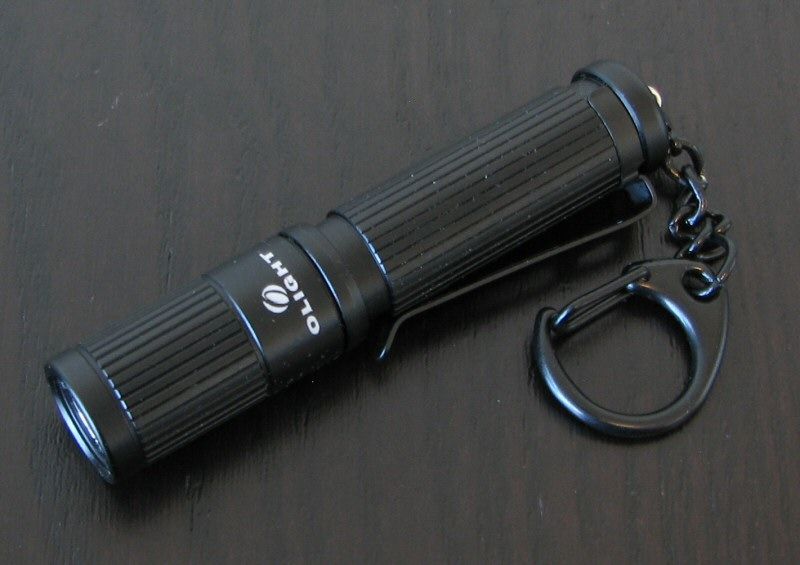
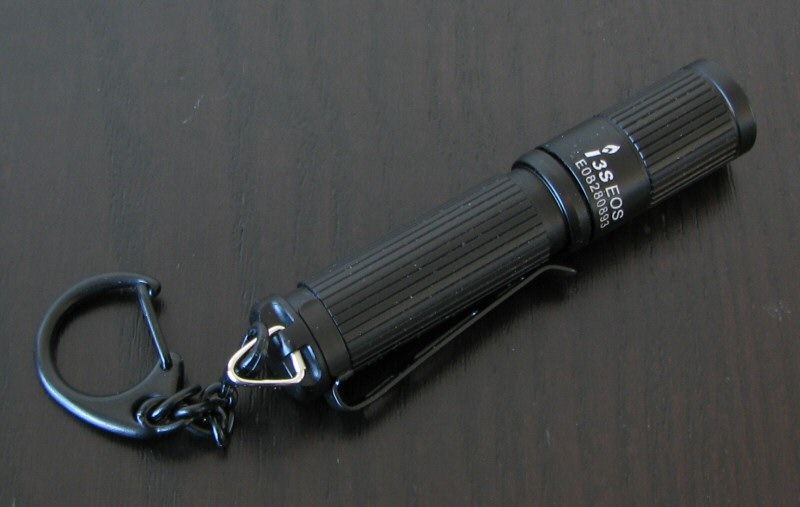
The i3S from Olight has a long history. Originally launched under the ITP brand as the A3 (in 2009) with a XP-E emitter, it migrated through several versions until Olight integrated it in-house as the i3 at the end of 2011 (with a XP-G emitter). In early 2013, it went through another upgrade, becoming the i3S (with a XP-G2 emitter and new circuit).
Although I have reviewed several of the previous incarnations, I thought it was about time that I added the currently available i3S to the fold. As far as I am aware, the currently shipping i3S has remained unchanged over the last year and a half (since early 2013). A significant upgrade that came with the i3S model is the switch to a fully current-controlled circuit.
Let's see how it compares to the modern competition.
Manufacturer Reported Specifications:
(note: as always, these are simply what the manufacturer/dealer provides – scroll down to see my actual testing results).
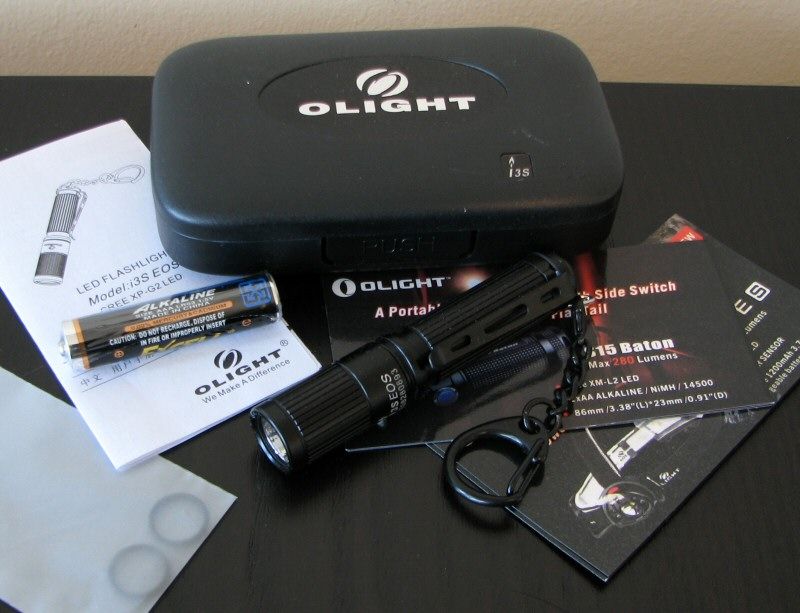
Ii3S packaging is stylish, with a light-weight plastic case with a spring-loaded top. Inside, in packing foam is the light with pocket clip attached, extra o-rings, alkaline AAA battery, package insert and manual.
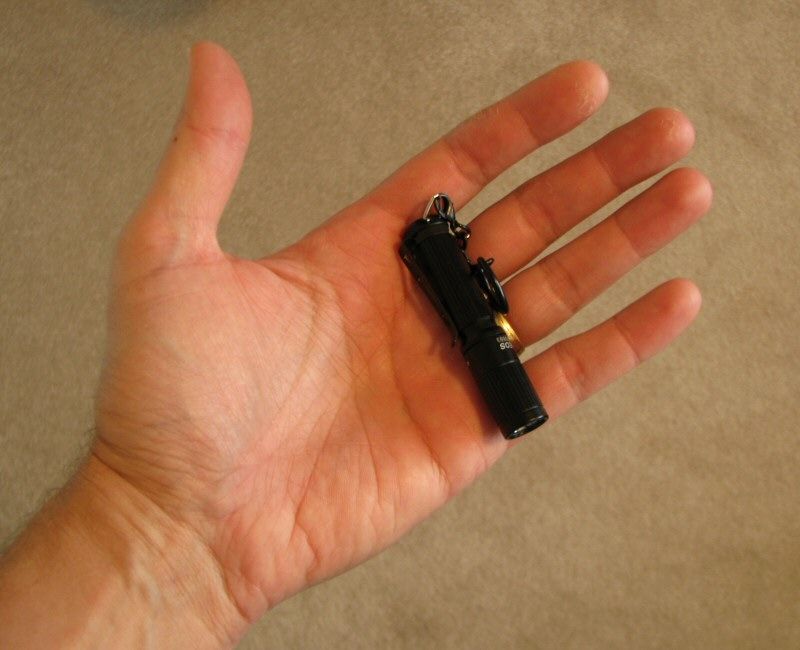
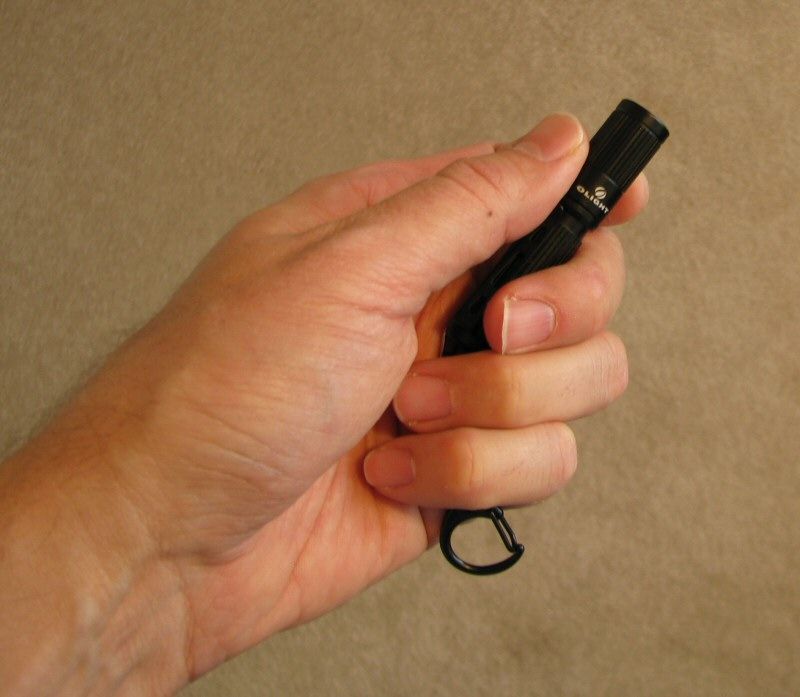
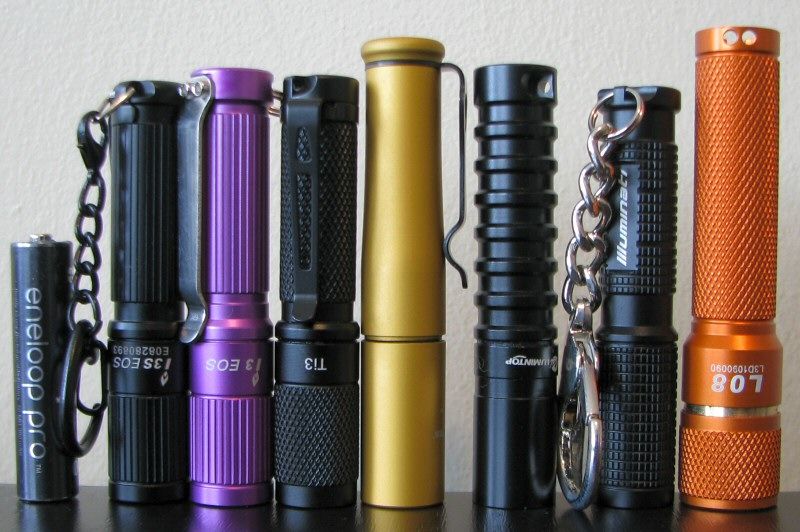
From left to right: Panasonic Eneloop Pro NiMH AAA; Olight i3S (2014), i3 (2011); Thrunite Ti3, Foursevens Preon P1; Lumintop Worm; Titanium Innovations Illumnati; L3 Illumination L08.
All dimensions directly measured, and given with no batteries installed (and without keychain ring, where removable):
Olight i3 (2013/14): Weight 12.3g, Length: 69.3mm, Width (bezel): 14.0mm
Olight i3 (2011): Weight 13.2g, Length: 71.9mm, Width (bezel): 14.0mm
ITP A3 "Upgraded" (2009): Weight: 11.6g, Length: 69.7mm, Width (bezel): 14.1mm
Thrunite Ti3: Weight: 11.5g, Length: 69.9mm, Width (bezel): 13.6mm
Foursevens Preon P0: Weight 13.0g (with keychain clip), Length 55.0mm, Width 12.6mm (bezel)
Foursevens Preon P1: Weight 15.3g (with keychain clip), Length 75.6mm, Width 14.0mm (bezel)
Klarus Mi X6: Weight 16.2g, Length 72.9mm (battery installed), Width 12.8mm
L3 Illumination L08: Weight: 22.4g, Length: 77.8mm, Width (bezel): 17.0mm
Lumintop Tool AAA: Weight: 15.3g, Length 82.6mm, Width 14.4mm (bezel)
Lumintop Worm Aluminum: Weight: 14.3g, Length 72.0mm (battery installed, off), Width 14.1mm (bezel)
Titanium Innovations Illuminati Aluminum: Weight 13.9g (with keychain clip), Length 68.8mm, Width 14.0mm (bezel)
As you can see, the i3S remains in keeping with other 1xAAA lights that use a similar mechanism. It is slightly shorter than the previous generation i3.
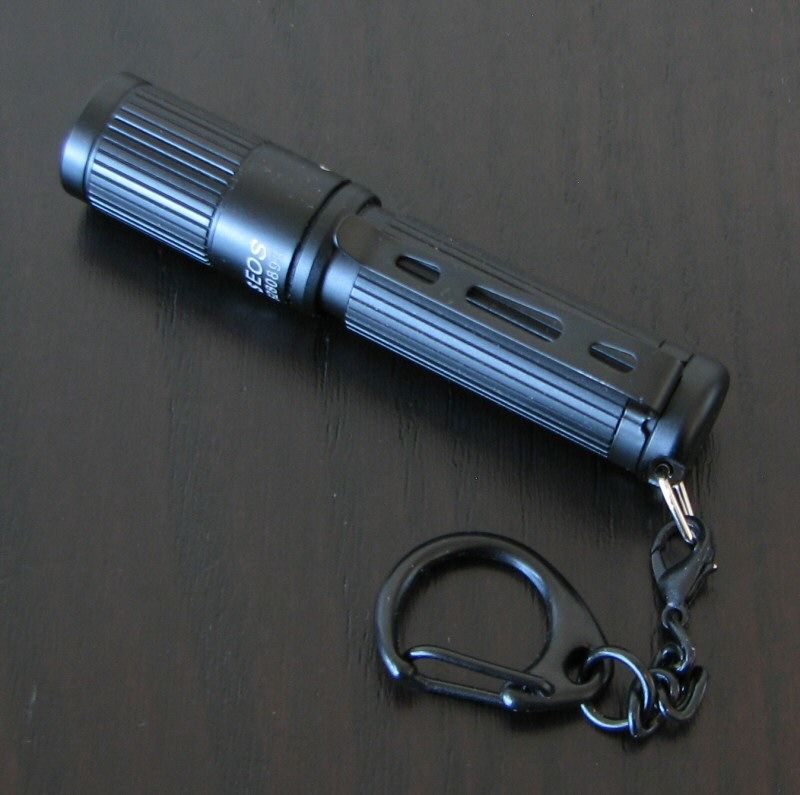
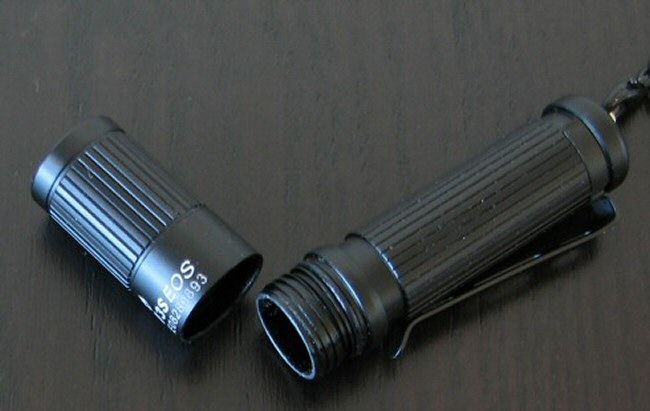
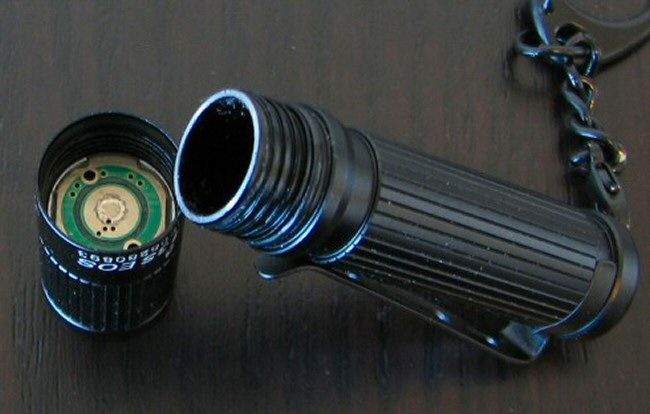
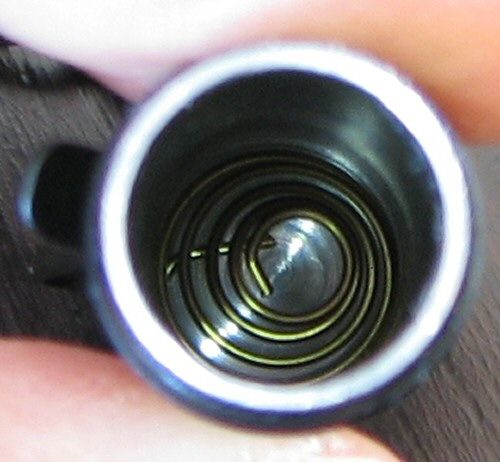
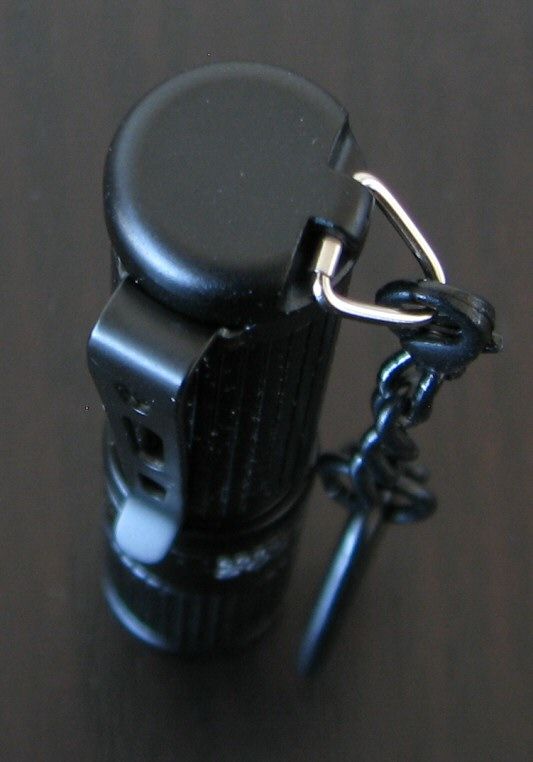
My sample came in flat black anodizing, but a range of colors are available for this model. Finish was good on my sample – no chips or blemishes. White lettering is clear and sharp. Like the earlier Olight/ITP versions, there is no knurling to speak of – instead, this series has always had length-wise ridge detail. Grip is ok, but is not as "grippy" as actual knurling would be.
Screw threads have been revised from the earlier A3/i3 models, and now feature square-cut threads. This is a definite improvement, as the old standard triangular cut threads were fairly fine (leading to some "play" in the head). Definitely a firmer feel now on the i3S. :thumbsup: Threads remain anodized (necessary for UI – scroll down for details).
As before, there is a circuit board in the head and a spring at the base of the battery tube. Fairly standard on these sorts of 1xAAA models.
There is a small triangular clip that holds the keychain ring to the light. Personally, I consider this a step backwards from the split-ring provided previously (i.e., these small triangular clips can typically deform and bend more easily). However, these kinds of connecting clips are becoming more common in this class. :shrug:
Thanks to the cut-out for the attachment point, tailstanding is stable and secure on the i3S (as before).
The supplied pocket clip is fairly basic, and similar to the original A3 clip (i.e., pull to extract it). Personally, I liked the more secure screwed on version of the clip supplied for the initial i3 release.
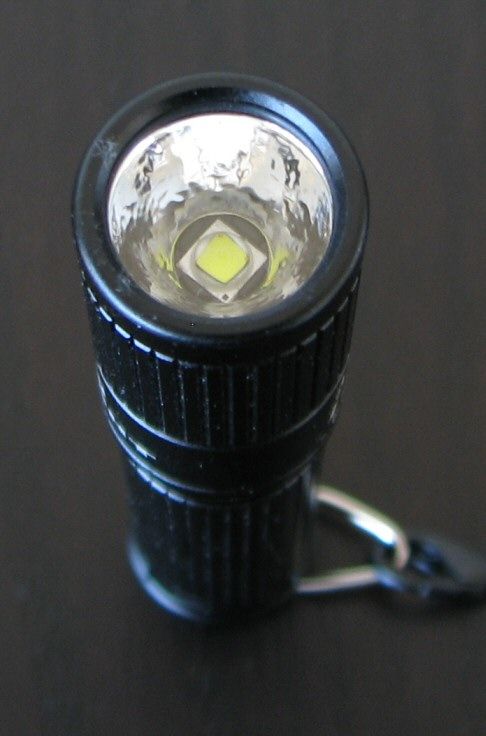
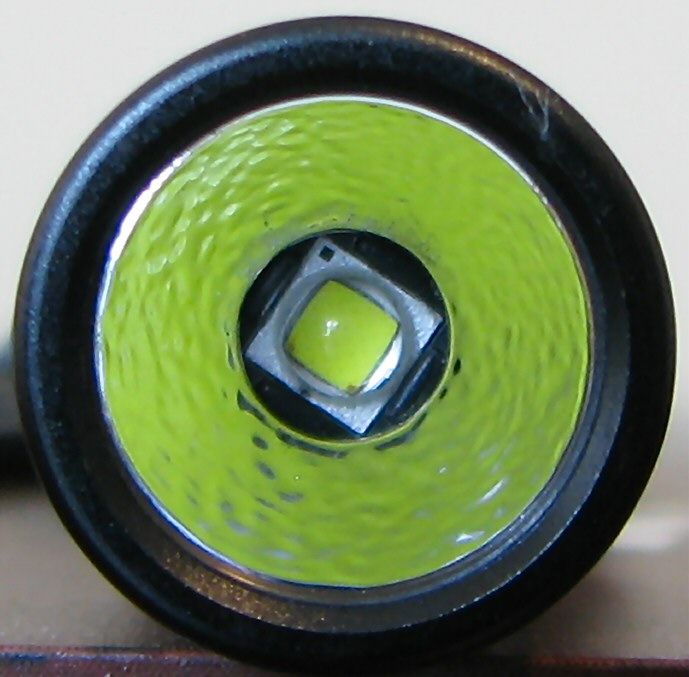
Centering was good on my sample above – note the XP-G2 at the base of the textured reflector. Please see my detailed beamshots later in this review.
User Interface
The A3 was one of the first keychain lights to use a twisty-style mode selection. Now quite common, the i3S has been updated from earlier models.
To turn the light on, fully tighten the head. To switch output modes, do a rapid twist off-on to advance to the next level. What has changed over time is the mode sequence. Here's a brief summary:
Original ITP A3 "Upgraded" version (2009): Med > Lo > Hi, in repeating sequence
Revised ITP A3 (2010): Lo > Med > Hi, in repeating sequence
Olight i3 (2011): Lo > Med > Hi, in repeating sequence
Olight i3S (2013/14): Lo > Hi > Moonlight, in repeating sequence
The key point above is that the i3S still moves in the "revised" sequence of lowest to highest at all times. The difference now is that the lower output levels have been revised (from Lo/Med to Moonlight/Lo), and the i3S defaults to the intermediate level (now known as Lo) when first activating.
There is a "hidden" strobe mode on the i3S now. To activate, run through the main sequence levels twice (i.e. 6 sets of loosen/tighten) as follows: Lo > Hi > Moonlight > Lo > Hi > Moonlight > Strobe. Simply loosen/tighten again (or turn off) to exist Strobe.
Video:
For information on the light, including the build and user interface, please see my video overview:
For all my videos, I recommend you have annotations turned on. I commonly update the commentary with additional information or clarifications before publicly releasing the video.
As an aside, if you want to get an instant notification for every new review that I post, you can subscribe to my YouTube channel. The vids go public at the same time as the reviews here on CPF.
PWM
There is no sign of pulse width modulation (PWM) at any output level on the i3S – the light appears to be fully current-controlled and flicker-free.
Note that this is a departure from the earlier A3/i3 lights. The original A3 "Upgraded" used a very visible 200 Hz PWM. Later generations of the A3 (and the original Olight i3) used a much higher PWM frequency of 2.4 kHz. This frequency was high enough that the PWM was virtually undetectable, but did result in a slight efficiency reduction. The current-controlled circuit used here should provide the best performance.
Strobe:
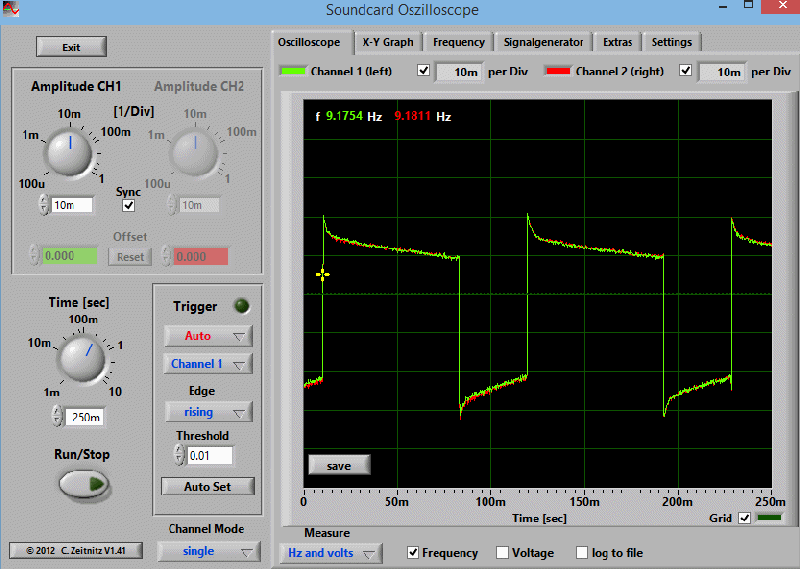
There was a relatively fast 9.2 Hz strobe on the i3S. Note the on-phase of the strobe pulse is lower than typical (i.e., ~33% on the i3S). Most lights at this frequency have a ~50% pulse width. It is not something that can notice by eye, and it doesn't really affect how distracting the strobe mode is (although I suppose it may extend the runtime).
Personally, I don't really see what anyone would want a fast strobe on a keychain light, but at least it is somewhat hidden.
Beamshots:
For white-wall beamshots below, all lights are on Max output on an Eneloop NiMH AAA. Lights are about ~0.75 meter from a white wall (with the camera ~1.25 meters back from the wall). Automatic white balance on the camera, to minimize tint differences.
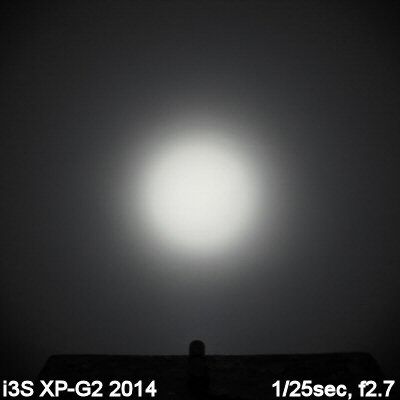
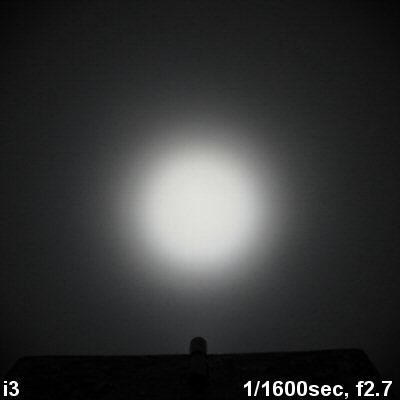
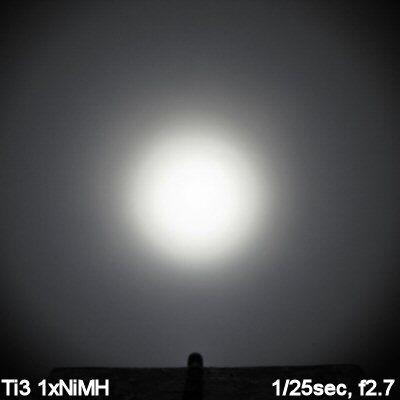
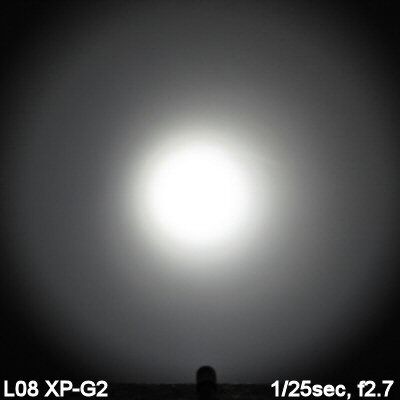
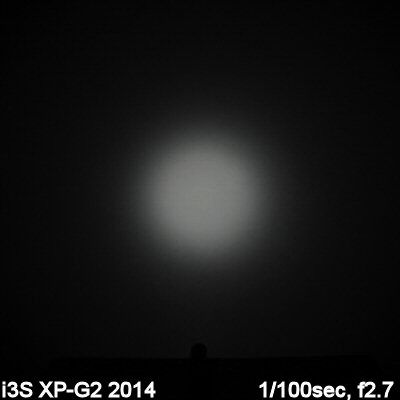
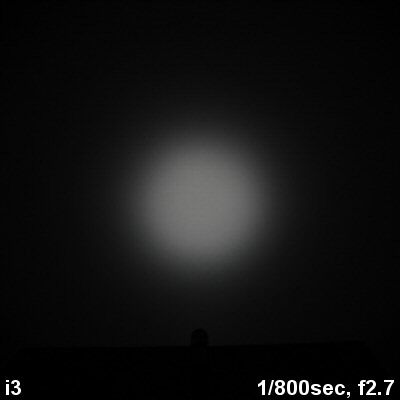
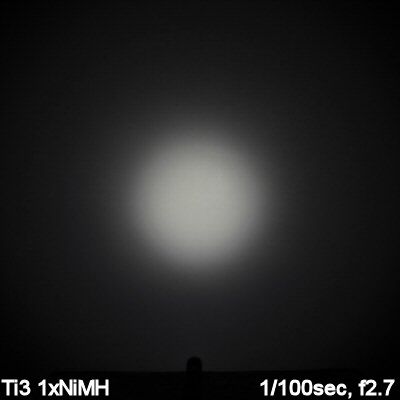
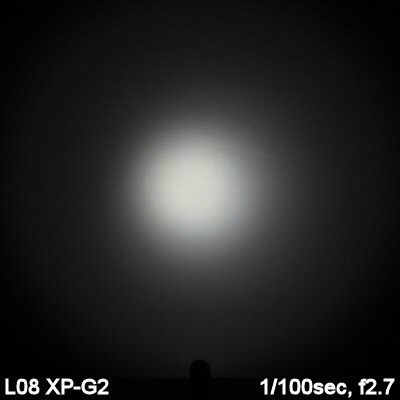
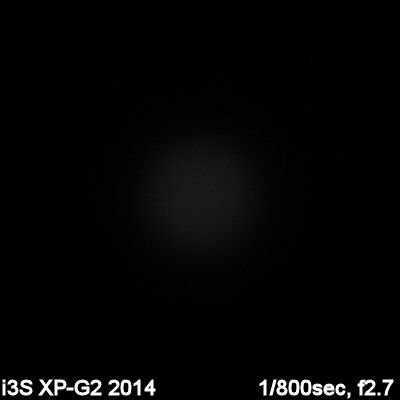
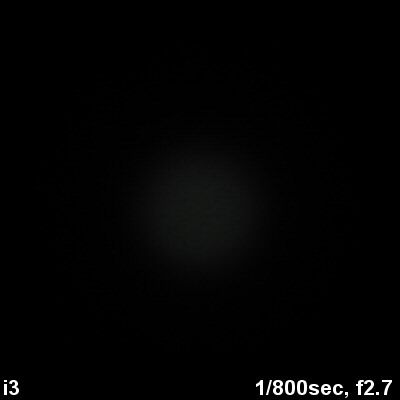
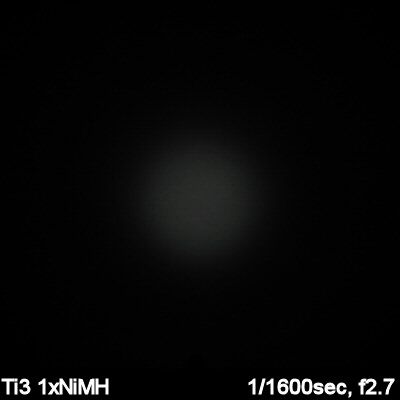
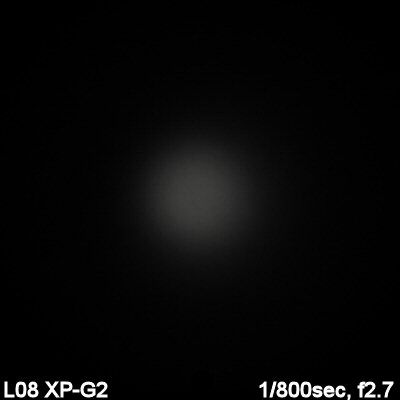
Pretty typical beam for a XP-G2-equipped light of this size. It doesn't look all that different from the original i3, except for a slightly more focused beam (at least on my one sample).
Testing Method:
All my output numbers are relative for my home-made light box setup, as described on my flashlightreviews.ca website. You can directly compare all my relative output values from different reviews - i.e. an output value of "10" in one graph is the same as "10" in another. All runtimes are done under a cooling fan, except for any extended run Lo/Min modes (i.e. >12 hours) which are done without cooling.
I have devised a method for converting my lightbox relative output values (ROV) to estimated Lumens. See my How to convert Selfbuilt's Lightbox values to Lumens thread for more info.
My summary tables are reported in a manner consistent with the ANSI FL-1 standard for flashlight testing. Please see http://www.flashlightreviews.ca/FL1.htm for a discussion, and a description of all the terms used in these tables. Effective July 2012, I have updated all my Peak Intensity/Beam Distance measures with a NIST-certified Extech EA31 lightmeter (orange highlights).
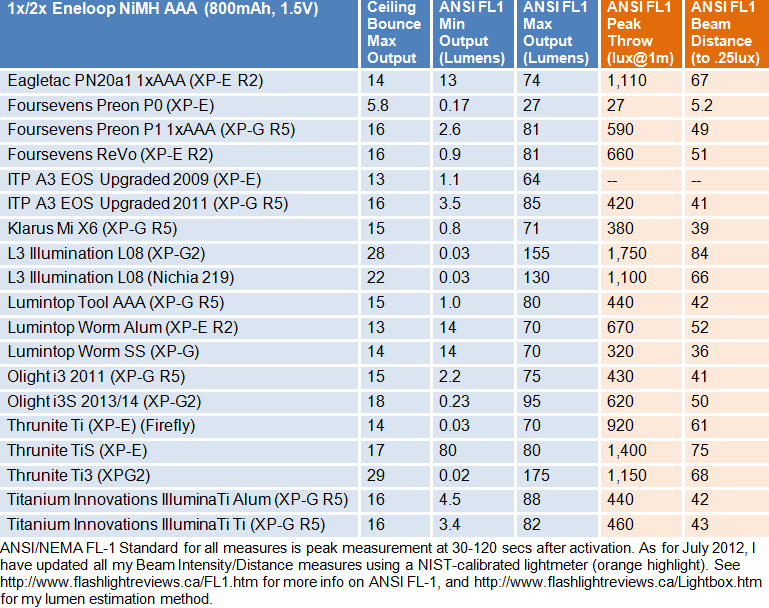
I've included two iterations of the ITP A3 above, as well as the first generation Olight i3. As you can see, the max output has increased over time, but not by much over the last few years. Low output has dropped on this most recent version. The A3/i3 has never been much of a thrower, given the small head.
To give you a better idea of how the new i3S compares to the original Olight i3, here is a lumen estimate comparison at all levels:
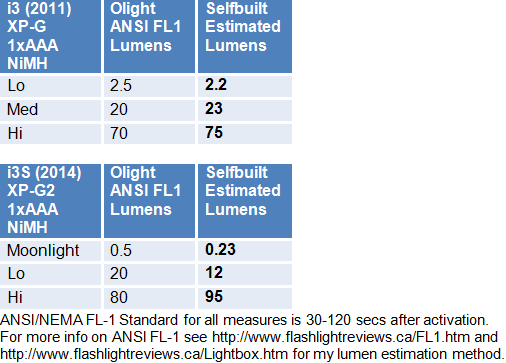
The specs would suggest the current i3S Lo mode is the same output as the old i3 Med mode (i.e., 20 lumens). However, that is not the case in my testing – the i3S Lo mode is about half that of the old i3 Med (i.e., 12 vs 23 estimated lumens, in my lightbox). Of course, that is based on only 1-2 samples of each light - but that degree of variation with a circuit change is a good indicator that the levels really are different across models. The new Moonlight mode is indeed considerably lower than the old Lo.
Overall, I personally like the revised mode levels – but then I'm a fan of truly low output lights. One point to the above is that you should expect considerably longer runtime on the i3S Lo mode, compare to the old i3 Med mode (due to the lower output and the switch to a more efficient current-controlled circuit).
Runtimes
I'm starting to migrate to the current generation of Panasonic Eneloop Pro NiMH cells. For AAA, these are basically the same as the second generation Sanyo Eneloop "XX-powered" Pro cells, now manufactured under the Panasonic name. They have a typical capacity of 950mAh (900mAh min), which is higher than the original Sanyo AAA Eneloops (typical 800mAh). For the time being, I will show both types of cells in my reviews.
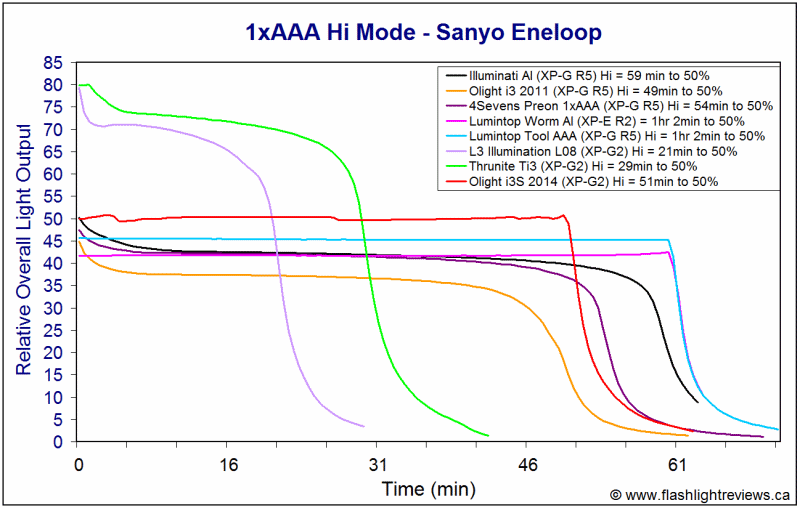
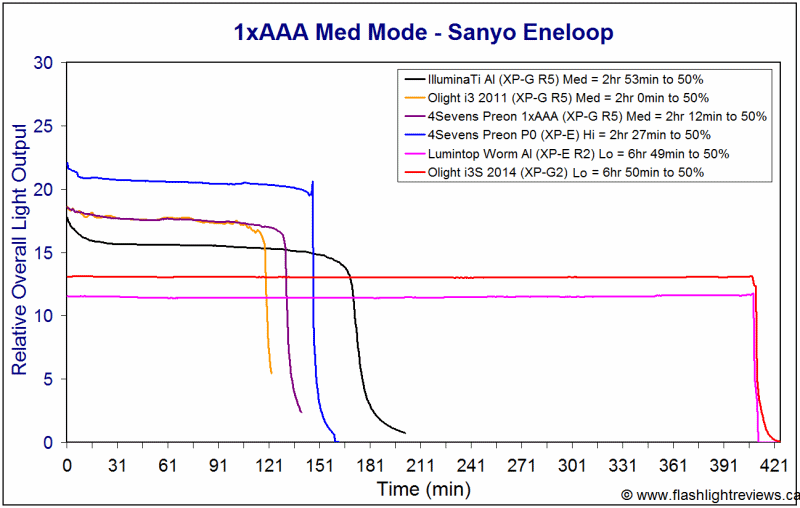
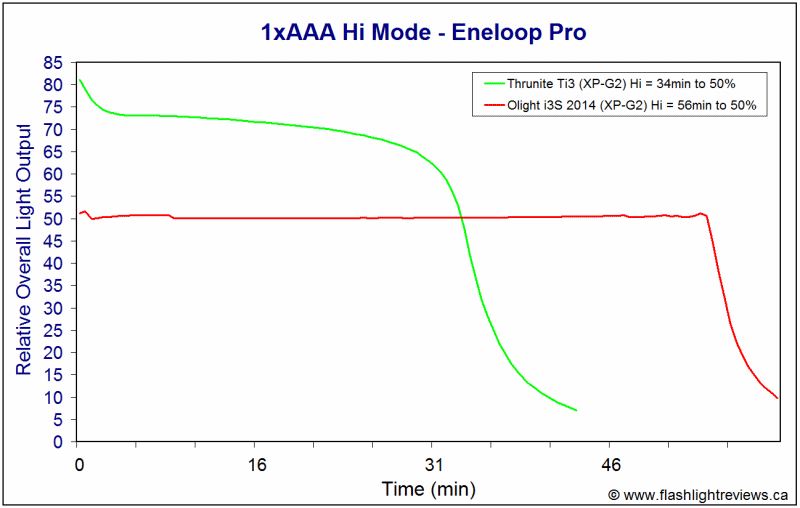
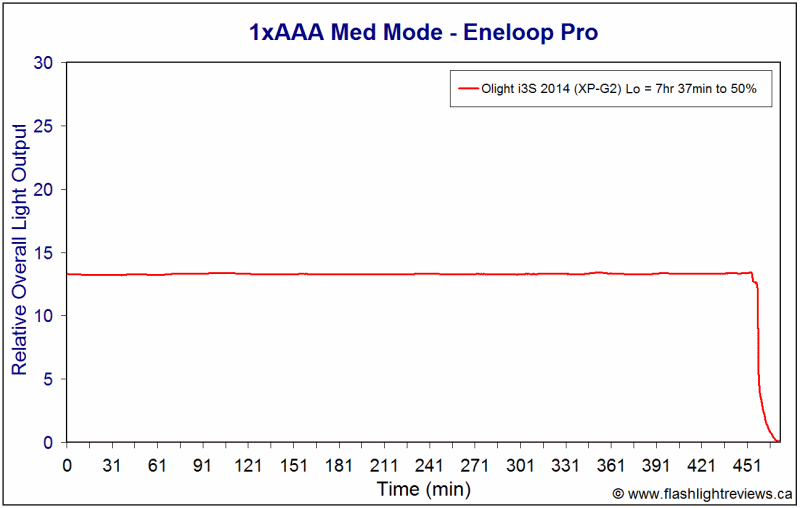
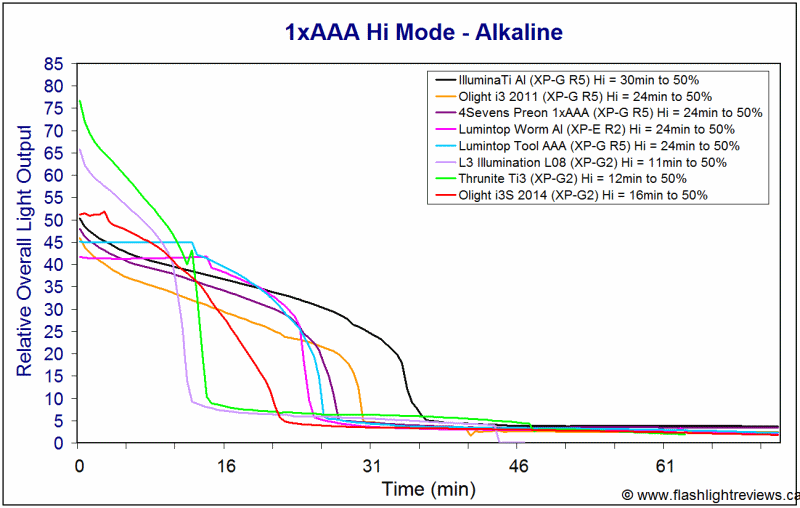
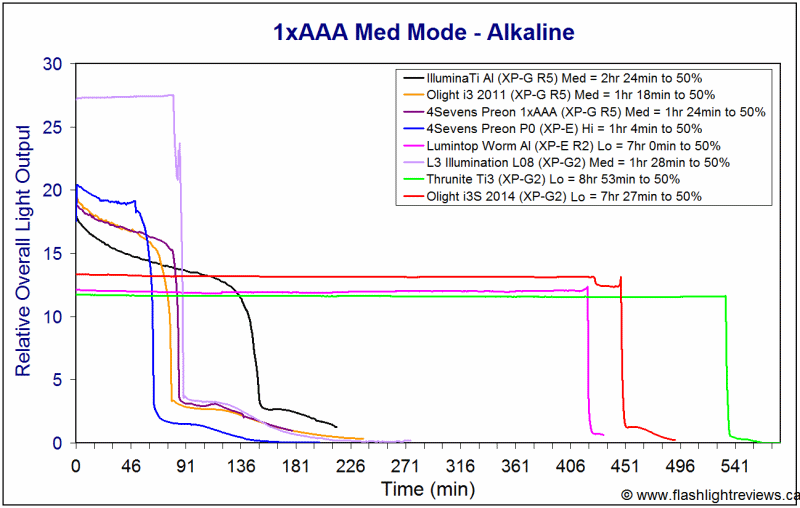
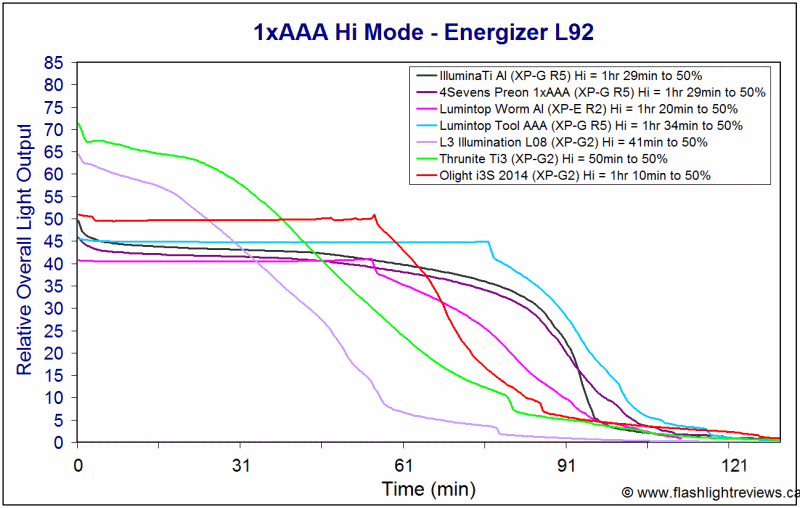
The i3S is driven to a reasonable level on Hi – and as such, shows very good runtime and stabilization (regulation) compared to some other recent members of this 1xAAA class. As usual though, you can only expect so much on regular alkaline AAA – I recommend the use of quality NiMH or L92 lithium cells.
On Lo, you can see that the i3S is a top performer in my testing - for both output/runtime efficiency and flat stabilization. Again, this is thanks to the switch to a current-controlled circuit on the i3S, from the earlier high frequency PWM of the A3/i3.
Again, this is thanks to the switch to a current-controlled circuit on the i3S, from the earlier high frequency PWM of the A3/i3.
Potential Issues
The i3S is not as grippy as some lights with actual knurling. However, the fluted ridges along the length help with grip, and the new square-cut threads make it easier for one-handed operation now.
The triangular keychain attachment point for the keychain is pretty basic, as is the removable pocket clip (i.e., no split-ring and screwed-on clip any more).
The i3S has a "hidden" fast strobe mode – although in practice, this means it will take time to activate it when you want it, and you may still accidentally activate on occasion.
10440 Li-ion is not supported.
Preliminary Observations
This version of the i3S has been out for over a year and half now, but I thought it would be good to finally add it to my testing results. The A3/i3 series lights have certainly evolved a lot from their first release (see my reviews from 2009 and 2011). As usual, I consider this latest version to an overall upgrade to the earlier series lights.
The biggest difference for the i3S (released in early 2013) is the wholly new circuit. Gone is the pulse width modulation of the earlier models, replaced by a fully current-controlled circuit. Output level spacing and mode sequence have also been revised, for a generally better implementation (in my view). As you will see in the runtimes section above, overall efficiency is excellent on this latest model. :thumbsup:
One thing I don't really get is the addition of a fast strobe mode on a keychain light. If you were going to bother, a slow signaling strobe or beacon would have made more sense to me. At least it is not particularly easy to access (i.e., six twists required) – but that also means that you are not going to "surprise" anyone with it.
Build-wise, the light is similar to before - but features square-cut threads now, which greatly reduce the "play" in the head (and facilitates one-handed operation). Emitter has been updated to XP-G2, as you would expect. I am a little disappointed to see the reversion to the earlier style snap-on pocket clip, and the simpler keychain attachment point, but these are still serviceable.
The i3S is similar in overall functionality to a number of other recent twisty-style keychain lights on the market. Hopefully you will find this review helps fill in my analysis of the 1xAAA space a little further. Given their ease of carry, I know this is a popular class for keychain use. :wave:
----
i3S supplied by Gearbest.com for review (SKU LL0135501).


The i3S from Olight has a long history. Originally launched under the ITP brand as the A3 (in 2009) with a XP-E emitter, it migrated through several versions until Olight integrated it in-house as the i3 at the end of 2011 (with a XP-G emitter). In early 2013, it went through another upgrade, becoming the i3S (with a XP-G2 emitter and new circuit).
Although I have reviewed several of the previous incarnations, I thought it was about time that I added the currently available i3S to the fold. As far as I am aware, the currently shipping i3S has remained unchanged over the last year and a half (since early 2013). A significant upgrade that came with the i3S model is the switch to a fully current-controlled circuit.
Let's see how it compares to the modern competition.
Manufacturer Reported Specifications:
(note: as always, these are simply what the manufacturer/dealer provides – scroll down to see my actual testing results).
- LED: Cree XP-G2
- 4 Modes: High > Mid > Low > Strobe (10Hz)
- Output/Runtime: 80 lumens / 35min – 20 lumens / 8hr – 0.5 lumens / 60hr
- Battery Type/Quantity: 1 x AAA or NiMH Battery (not included)
- Reflector: Aluminum Textured Orange Peel Reflector
- Lens: Toughened Ultra-clear Glass Lens with Anti-reflective Coating
- Impact Resistance: 1.2m
- Water Resistance: IPX8
- Beam Intensity: 360 cd
- Beam Distance: 38m
- Body Material: Aluminum Alloy
- Available Color: Blue, Black, Purple, Red, Gold
- Weight: 11g (without battery)
- Dimensions: (L) 70mm x (D) 14mm
- Package weight: 0.1 kg
- Package size (L x W x H): 10 x 5 x 2 cm
- Package Contents: 1 x Flashlight, 1 x AAA Battery
- MSRP: ~$17 with coupon (supplied by Gearbest.com for review, PM for coupon details)

Ii3S packaging is stylish, with a light-weight plastic case with a spring-loaded top. Inside, in packing foam is the light with pocket clip attached, extra o-rings, alkaline AAA battery, package insert and manual.



From left to right: Panasonic Eneloop Pro NiMH AAA; Olight i3S (2014), i3 (2011); Thrunite Ti3, Foursevens Preon P1; Lumintop Worm; Titanium Innovations Illumnati; L3 Illumination L08.
All dimensions directly measured, and given with no batteries installed (and without keychain ring, where removable):
Olight i3 (2013/14): Weight 12.3g, Length: 69.3mm, Width (bezel): 14.0mm
Olight i3 (2011): Weight 13.2g, Length: 71.9mm, Width (bezel): 14.0mm
ITP A3 "Upgraded" (2009): Weight: 11.6g, Length: 69.7mm, Width (bezel): 14.1mm
Thrunite Ti3: Weight: 11.5g, Length: 69.9mm, Width (bezel): 13.6mm
Foursevens Preon P0: Weight 13.0g (with keychain clip), Length 55.0mm, Width 12.6mm (bezel)
Foursevens Preon P1: Weight 15.3g (with keychain clip), Length 75.6mm, Width 14.0mm (bezel)
Klarus Mi X6: Weight 16.2g, Length 72.9mm (battery installed), Width 12.8mm
L3 Illumination L08: Weight: 22.4g, Length: 77.8mm, Width (bezel): 17.0mm
Lumintop Tool AAA: Weight: 15.3g, Length 82.6mm, Width 14.4mm (bezel)
Lumintop Worm Aluminum: Weight: 14.3g, Length 72.0mm (battery installed, off), Width 14.1mm (bezel)
Titanium Innovations Illuminati Aluminum: Weight 13.9g (with keychain clip), Length 68.8mm, Width 14.0mm (bezel)
As you can see, the i3S remains in keeping with other 1xAAA lights that use a similar mechanism. It is slightly shorter than the previous generation i3.





My sample came in flat black anodizing, but a range of colors are available for this model. Finish was good on my sample – no chips or blemishes. White lettering is clear and sharp. Like the earlier Olight/ITP versions, there is no knurling to speak of – instead, this series has always had length-wise ridge detail. Grip is ok, but is not as "grippy" as actual knurling would be.
Screw threads have been revised from the earlier A3/i3 models, and now feature square-cut threads. This is a definite improvement, as the old standard triangular cut threads were fairly fine (leading to some "play" in the head). Definitely a firmer feel now on the i3S. :thumbsup: Threads remain anodized (necessary for UI – scroll down for details).
As before, there is a circuit board in the head and a spring at the base of the battery tube. Fairly standard on these sorts of 1xAAA models.
There is a small triangular clip that holds the keychain ring to the light. Personally, I consider this a step backwards from the split-ring provided previously (i.e., these small triangular clips can typically deform and bend more easily). However, these kinds of connecting clips are becoming more common in this class. :shrug:
Thanks to the cut-out for the attachment point, tailstanding is stable and secure on the i3S (as before).
The supplied pocket clip is fairly basic, and similar to the original A3 clip (i.e., pull to extract it). Personally, I liked the more secure screwed on version of the clip supplied for the initial i3 release.


Centering was good on my sample above – note the XP-G2 at the base of the textured reflector. Please see my detailed beamshots later in this review.
User Interface
The A3 was one of the first keychain lights to use a twisty-style mode selection. Now quite common, the i3S has been updated from earlier models.
To turn the light on, fully tighten the head. To switch output modes, do a rapid twist off-on to advance to the next level. What has changed over time is the mode sequence. Here's a brief summary:
Original ITP A3 "Upgraded" version (2009): Med > Lo > Hi, in repeating sequence
Revised ITP A3 (2010): Lo > Med > Hi, in repeating sequence
Olight i3 (2011): Lo > Med > Hi, in repeating sequence
Olight i3S (2013/14): Lo > Hi > Moonlight, in repeating sequence
The key point above is that the i3S still moves in the "revised" sequence of lowest to highest at all times. The difference now is that the lower output levels have been revised (from Lo/Med to Moonlight/Lo), and the i3S defaults to the intermediate level (now known as Lo) when first activating.
There is a "hidden" strobe mode on the i3S now. To activate, run through the main sequence levels twice (i.e. 6 sets of loosen/tighten) as follows: Lo > Hi > Moonlight > Lo > Hi > Moonlight > Strobe. Simply loosen/tighten again (or turn off) to exist Strobe.
Video:
For information on the light, including the build and user interface, please see my video overview:
For all my videos, I recommend you have annotations turned on. I commonly update the commentary with additional information or clarifications before publicly releasing the video.
As an aside, if you want to get an instant notification for every new review that I post, you can subscribe to my YouTube channel. The vids go public at the same time as the reviews here on CPF.
PWM
There is no sign of pulse width modulation (PWM) at any output level on the i3S – the light appears to be fully current-controlled and flicker-free.
Note that this is a departure from the earlier A3/i3 lights. The original A3 "Upgraded" used a very visible 200 Hz PWM. Later generations of the A3 (and the original Olight i3) used a much higher PWM frequency of 2.4 kHz. This frequency was high enough that the PWM was virtually undetectable, but did result in a slight efficiency reduction. The current-controlled circuit used here should provide the best performance.
Strobe:

There was a relatively fast 9.2 Hz strobe on the i3S. Note the on-phase of the strobe pulse is lower than typical (i.e., ~33% on the i3S). Most lights at this frequency have a ~50% pulse width. It is not something that can notice by eye, and it doesn't really affect how distracting the strobe mode is (although I suppose it may extend the runtime).
Personally, I don't really see what anyone would want a fast strobe on a keychain light, but at least it is somewhat hidden.
Beamshots:
For white-wall beamshots below, all lights are on Max output on an Eneloop NiMH AAA. Lights are about ~0.75 meter from a white wall (with the camera ~1.25 meters back from the wall). Automatic white balance on the camera, to minimize tint differences.












Pretty typical beam for a XP-G2-equipped light of this size. It doesn't look all that different from the original i3, except for a slightly more focused beam (at least on my one sample).
Testing Method:
All my output numbers are relative for my home-made light box setup, as described on my flashlightreviews.ca website. You can directly compare all my relative output values from different reviews - i.e. an output value of "10" in one graph is the same as "10" in another. All runtimes are done under a cooling fan, except for any extended run Lo/Min modes (i.e. >12 hours) which are done without cooling.
I have devised a method for converting my lightbox relative output values (ROV) to estimated Lumens. See my How to convert Selfbuilt's Lightbox values to Lumens thread for more info.
My summary tables are reported in a manner consistent with the ANSI FL-1 standard for flashlight testing. Please see http://www.flashlightreviews.ca/FL1.htm for a discussion, and a description of all the terms used in these tables. Effective July 2012, I have updated all my Peak Intensity/Beam Distance measures with a NIST-certified Extech EA31 lightmeter (orange highlights).

I've included two iterations of the ITP A3 above, as well as the first generation Olight i3. As you can see, the max output has increased over time, but not by much over the last few years. Low output has dropped on this most recent version. The A3/i3 has never been much of a thrower, given the small head.
To give you a better idea of how the new i3S compares to the original Olight i3, here is a lumen estimate comparison at all levels:

The specs would suggest the current i3S Lo mode is the same output as the old i3 Med mode (i.e., 20 lumens). However, that is not the case in my testing – the i3S Lo mode is about half that of the old i3 Med (i.e., 12 vs 23 estimated lumens, in my lightbox). Of course, that is based on only 1-2 samples of each light - but that degree of variation with a circuit change is a good indicator that the levels really are different across models. The new Moonlight mode is indeed considerably lower than the old Lo.
Overall, I personally like the revised mode levels – but then I'm a fan of truly low output lights. One point to the above is that you should expect considerably longer runtime on the i3S Lo mode, compare to the old i3 Med mode (due to the lower output and the switch to a more efficient current-controlled circuit).
Runtimes
I'm starting to migrate to the current generation of Panasonic Eneloop Pro NiMH cells. For AAA, these are basically the same as the second generation Sanyo Eneloop "XX-powered" Pro cells, now manufactured under the Panasonic name. They have a typical capacity of 950mAh (900mAh min), which is higher than the original Sanyo AAA Eneloops (typical 800mAh). For the time being, I will show both types of cells in my reviews.







The i3S is driven to a reasonable level on Hi – and as such, shows very good runtime and stabilization (regulation) compared to some other recent members of this 1xAAA class. As usual though, you can only expect so much on regular alkaline AAA – I recommend the use of quality NiMH or L92 lithium cells.
On Lo, you can see that the i3S is a top performer in my testing - for both output/runtime efficiency and flat stabilization.
Potential Issues
The i3S is not as grippy as some lights with actual knurling. However, the fluted ridges along the length help with grip, and the new square-cut threads make it easier for one-handed operation now.
The triangular keychain attachment point for the keychain is pretty basic, as is the removable pocket clip (i.e., no split-ring and screwed-on clip any more).
The i3S has a "hidden" fast strobe mode – although in practice, this means it will take time to activate it when you want it, and you may still accidentally activate on occasion.
10440 Li-ion is not supported.
Preliminary Observations
This version of the i3S has been out for over a year and half now, but I thought it would be good to finally add it to my testing results. The A3/i3 series lights have certainly evolved a lot from their first release (see my reviews from 2009 and 2011). As usual, I consider this latest version to an overall upgrade to the earlier series lights.
The biggest difference for the i3S (released in early 2013) is the wholly new circuit. Gone is the pulse width modulation of the earlier models, replaced by a fully current-controlled circuit. Output level spacing and mode sequence have also been revised, for a generally better implementation (in my view). As you will see in the runtimes section above, overall efficiency is excellent on this latest model. :thumbsup:
One thing I don't really get is the addition of a fast strobe mode on a keychain light. If you were going to bother, a slow signaling strobe or beacon would have made more sense to me. At least it is not particularly easy to access (i.e., six twists required) – but that also means that you are not going to "surprise" anyone with it.
Build-wise, the light is similar to before - but features square-cut threads now, which greatly reduce the "play" in the head (and facilitates one-handed operation). Emitter has been updated to XP-G2, as you would expect. I am a little disappointed to see the reversion to the earlier style snap-on pocket clip, and the simpler keychain attachment point, but these are still serviceable.
The i3S is similar in overall functionality to a number of other recent twisty-style keychain lights on the market. Hopefully you will find this review helps fill in my analysis of the 1xAAA space a little further. Given their ease of carry, I know this is a popular class for keychain use. :wave:
----
i3S supplied by Gearbest.com for review (SKU LL0135501).
Last edited:

